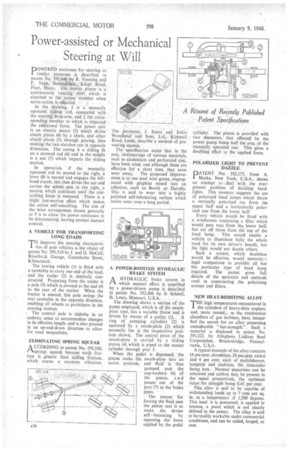Power-assisted or Mechanical Steering at Will
Page 62

If you've noticed an error in this article please click here to report it so we can fix it.
DOWERED assistance for steering or I similar purposes is described in patent No. 592.640 by R. yenning and E. Tapp, Surnme-rdale, kings . ROad, Fleet, Hants. 1 he motive power is -a.., continuously running shaft which is clutched to the output member when
servo-action is ,required.
In the drawing, I is a manually operated s,liding rod, connected with the steering drop arm and 2 the corresponding member to which is imparted the additional force. The power unit is an electric Motor (3) which drives clutch plates (4). by a chain, and other clutch": plates (5) through gearing, thus making the two clutches run in opposite directions. The casing is a sliding fit on a screwed rod (b) and in the middle is a nut (7) which imparts -the sliding motion.
In operation, -if the manually operated rod be moved_ to the right, a lever (8) is moved and engages the lefthand clutch; this then drives the nut and carries the whole unit tothe right, a motion ivhich continues" untilthe controlling lorce is removed. There is a slight lost-motion effect which makes the action self-cancelling. The aim of the lever arrangement shown generally at 9 is to allow the power assistance to be disconnected, leaving normal manual control.
A VEHICLE' FOR TRANSPORTING LONG LOADS
TO iwrove the steering characteristics of pole vehicles is the object of patent No 591,518 by J and D. McCall, RiverbaA. Garage, Greenholm Street, Kilmarnock.
The towing vehicle (1) is fitted with a turntable to carry one end of the load, and the trailer (2) is similarly constructed. Projecting from the trailer is a pole (3) which is pivoted at the end (4) to the rear of the tractor When the tractor is steered, this pole swings the rear turntable in the opposite direction, enabling all wheels to participate in the . steering motion.
The control pole is slidable in an endwise sense to accommodate changes in its effective length, and is also pivoted in an up-and-down direction to allow for road inequalities.
ELIMINATING SPRING SQUEAK
A CCORDING to.-patent No.. 592,550, 1-1.springs squeak because statjt friction is treater than...slit:flag friction, whichcauses a resonant vibration.
The patentees, J. Ennis and Jonas Woodhead and Sons, Ltd., Kirkstall Road, Leeds, describe a method of preventing squeak.
The specification states that in the past, interleavings of various materials, such as aluminium and perforated zinc, have been tried, and although these are effective for a short time, they soon wear away. The proposed improvement is to use steel wire gauze, impregnated with graphite mixed into an adhesive, such as Bostik or Durofix. This is said to wear into a highly polished self-lubricating surface which resists wear over a long period.
• , A POWER-BOOSTED HYDRAULIC BRAKE SYSTEM
AHYDRAULIC brake system in which manual effort is amplified by a power-driven pump is described in patent No. 592,406 by S. Schnell,
St. Louis, Missouri, U.S.A.. .
The drawing shows a section of the pump employed, which is of the sWasli plate type, has a variable throw and is driven by Means of a pulley (1). . A ring of pumping cylinders (2) is operated by a swash-plate (3) • which normally lies in the inoperative position shown. The central pivot of. the swash-plate is carried by a sliding piston (4) which is piped to the master
cylinder through port 5.
• When the pedal is depressed, the piston rocks the swash-plate into an active position, and fluid' "is then pumped • past -the cup:washers. (6) of the piston, a n d passes out of the port-(7) to the brake Pipes.
" the reason for forcing the fluid past the piston seal is to make the device self balancing by opposing the force applied by the pedal
cylinder. The piston is provided with two diameters, that affected by the power pump being half the area of the manually, operated one. This gives a doubling effect to the applied force.
POLARIZED LIGHT TO PREVENT DAZZLE
PATENT No. 592,177, from A. Marks, New York, -U.S.A., shows an " attempt to ;deal with the everpresent problem of dazzling headlights. This inventor suggests the use of polarized head lamps which throw a vertically polarized ray from the upper half and a horizontally polarized one from the lower half'.
Every vehicle would be fitted with a windscreen containing a filter which Would pass rays from the lower half, but cut off those from the top of the head lamp. This would enable a vehicle to illuminate fully the whole road for its own driver's benefit, but the light would not dazzle others.
Such a system, which doubtless would be effective, would necessita:e legal compulsion to prohibit all but the particular type of head lamp required. The patent gives full details of the rvaterials and methods used in constructing the polarizing screens and filters.
NEW HEAT-RESISTING ALLOY
THE high temperatures encountered in the cylinders of heavy-duty engines, and, more recentlj, in the combustion chambers of gas turbines, have intensified the search for an alloy possessing considerable " hot-strength." Such a material is disclosed in patent No. 591,222, by Allegheny Ludlum Steel Corporation, Brackenridge, Pennsylvania, U.S.A.
A typical example of the alloy contains 14 per.oent. chromium, 20 peg cent. nickel and 4 per cent. each of molybdenum, tungsten and niobium, the remainder being iron. ; Normal impurities can be tolerated and carbon may be present in the usual proportion's, the optimum value for strength being 0.45 per cent. — This alloy is said to be capable of Withstanding loadi up to 7 tons per sq. in, at a temperature of 1,500 degrees. This load, it is presumed, is applied in tension, a point which is not clearly defined in the patent. The alloy is said to be readily workable under commercial conditions, and can be rolled, forged, or cast.




























































































